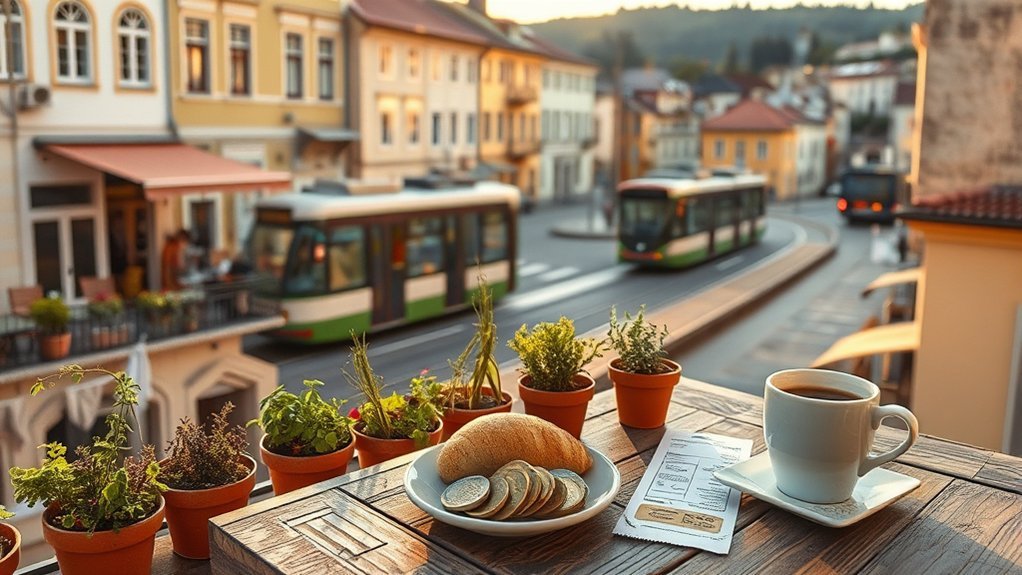You’ll need roughly €1,200–€1,500 monthly to live comfortably in Slovakia, with average after‑tax salaries around €1,447 and typical monthly expenses about €1,300. City‑center one‑bed rents average €681 (outside €533), utilities roughly €154, and public transport passes ~€20–€42. Eating out, groceries and healthcare are cheaper than Western Europe; student or peripheral options cut costs further. Keep this baseline in mind — further sections break down housing, transport, food and budgeting tips.
Overview of Slovakia’s Cost of Living and Key Numbers
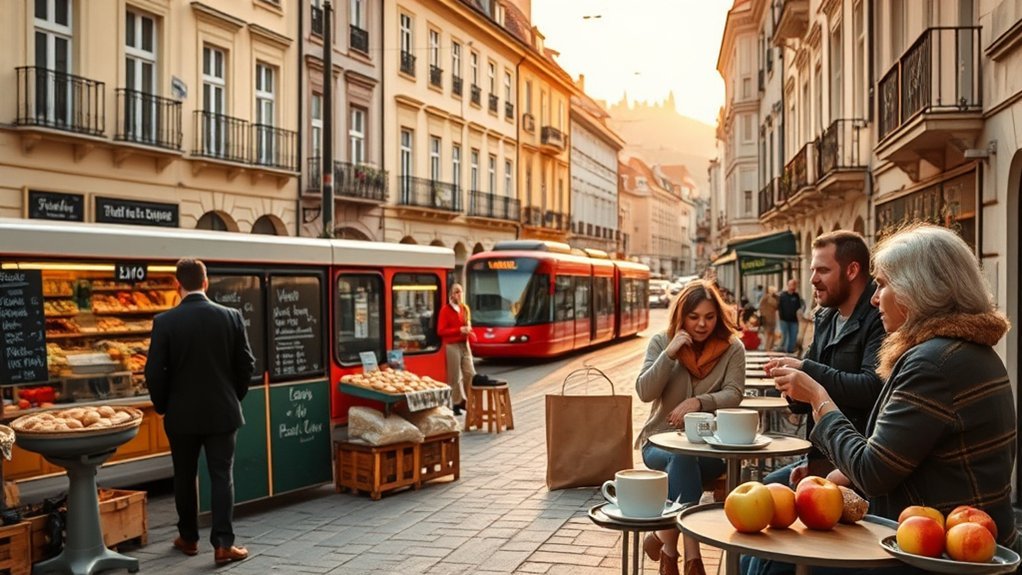
Although Slovakia’s monthly expenses are lower than in many Western European countries, you’ll find the average cost of living is roughly $1,300 a month, while the typical after-tax monthly salary is about $1,447—covering roughly 1.1 months of living costs.
You’ll notice that disposable income is slim but positive: the average salary slightly exceeds baseline living expenses, so you’re not running a deficit on average.
Breakdowns matter—utilities add about $154 monthly for a single person, public transport is affordable (single ticket ~$1.24, monthly ~$32.50), and eating out stays reasonable (budget meal ~$7, dinner for two ~$46.60).
Rent varies and impacts your budget considerably, but even without deep rent detail you’ll see non-housing essentials keep the cost of living moderate.
Compared to Western Europe, Slovakia offers lower everyday prices while wages lag, so your purchasing power depends on lifestyle choices and local wage levels.
Housing: Rent, Utilities and Where to Live
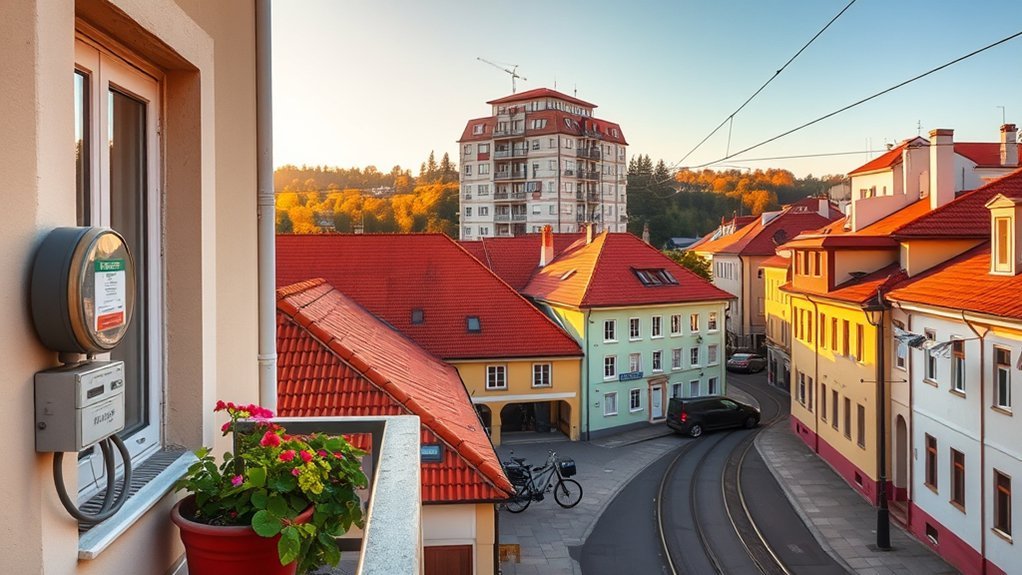
You’ll see big differences in rent depending on city and location: a one-bedroom in city centers averages $681 versus $533 outside, while three-bedrooms jump to about $1,185 in central areas.
Expect monthly utilities of roughly $154 for a single person and up to $207 for larger apartments, which can tip the monthly cost noticeably.
To find affordable neighbourhoods, compare prices between urban hubs like Bratislava and smaller towns, and consider student dorms from €12/night if budget is the priority.
Rent by City and Area
When comparing cities, expect wide rent variation: a one-bedroom in a city center averages about $681 versus $533 outside center, while three-bedrooms hit roughly $1,185 in centers and $893 for cheaper options, with monthly utilities around $154 adding to your costs; Bratislava typically commands the highest rents, whereas Košice and smaller cities are noticeably cheaper. You’ll weigh location, space and transport when living in Slovakia, balancing rent against amenities and even a prepaid mobile tariff for budget control. Compare neighborhoods: central areas cost more but save commute time; outskirts cut rent but add travel. Use data to pick value-for-money districts and plan monthly budgets around rent, furniture and basic services.
| Area Type | Typical Rent |
|---|---|
| City center (1BR) | $681 |
| Outside center (1BR) | $533 |
| City center (3BR) | $1,185 |
| Outside center (3BR) | $893 |
Utility Costs and Averages
Because utilities add a predictable layer to housing costs, you should budget roughly $154 per month for a single occupant’s basic services, with bills rising for larger apartments or higher consumption.
That $154 is a baseline: paired with a $681 one-bedroom city-center rent your total housing-related monthly outlay approaches $835, while a cheaper $533 option plus utilities lands near $687.
For a three-bedroom city-center unit at $1,185, expect utilities to push the total toward $1,339, or about $1,047 with a $893 less-central rent.
Costs scale with apartment size, consumption and city—Bratislava trends above national averages, Košice below.
Use these comparative figures to forecast budgets across unit sizes and locations, adjusting for heating season and amenity-driven utility use.
Finding Affordable Neighbourhoods
Utilities and rent together shape where you’ll want to live, so start by comparing city-center averages (one-bedroom $681, three-bedroom $1,185) with cheaper options ($533 one-bedroom, lower rents in rural areas) to spot savings opportunities.
You’ll weigh monthly utilities (~$154 per person) on top of rent: a city one-bedroom plus utilities totals about $835, while a cheaper one-bedroom plus utilities is roughly $687.
Two-room city-center units reaching $560 still push costs higher than comparable outskirts. Choose neighborhoods where rent-to-utility ratios are lower — smaller towns and peripheral districts often cut rent and slightly reduce utilities.
If you need space, compare city three-bedroom costs to rural three-bedroom offers; moving out can trim overall housing expenses substantially.
Food and Grocery Prices: Markets, Restaurants and Tips
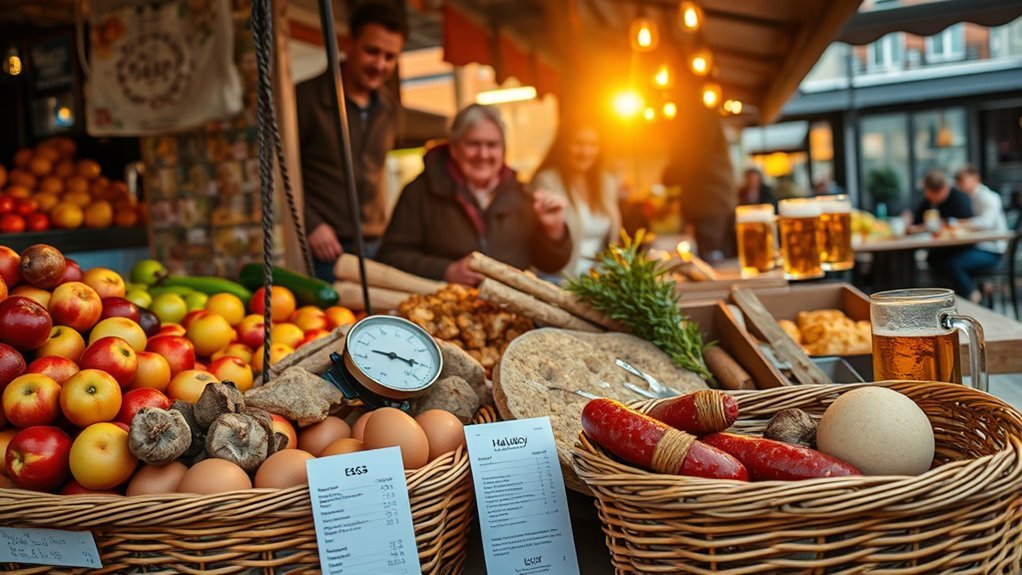
Though Slovakia’s dining and grocery scene varies by city, you’ll find clear value compared with Western Europe: a basic lunch averages $9.81 while dinner for two runs about $46.60. Inexpensive meals are around $7, a pub beer (0.5L) costs ~$2.46, and market produce like tomatoes (€4.90/kg) and apples (€1.70/kg) plus staples such as milk (€4.05/L) and a dozen eggs (€1.55) keep everyday food costs reasonable.
You’ll pay less eating out than in major Western capitals; casual lunches and inexpensive restaurants let you dine frequently without blowing your food budget. Shopping at local markets cuts costs further—seasonal produce undercuts supermarket prices and supports variety.
For staples, compare supermarkets for weekly promotions; bulk-buying milk and eggs rarely gives big savings, but discounts on pantry items add up. When socializing, beer prices make pubs affordable; reserve finer restaurants for special occasions given the higher per-person dinner cost.
Transportation Costs: Public Transit, Taxis and Fuel
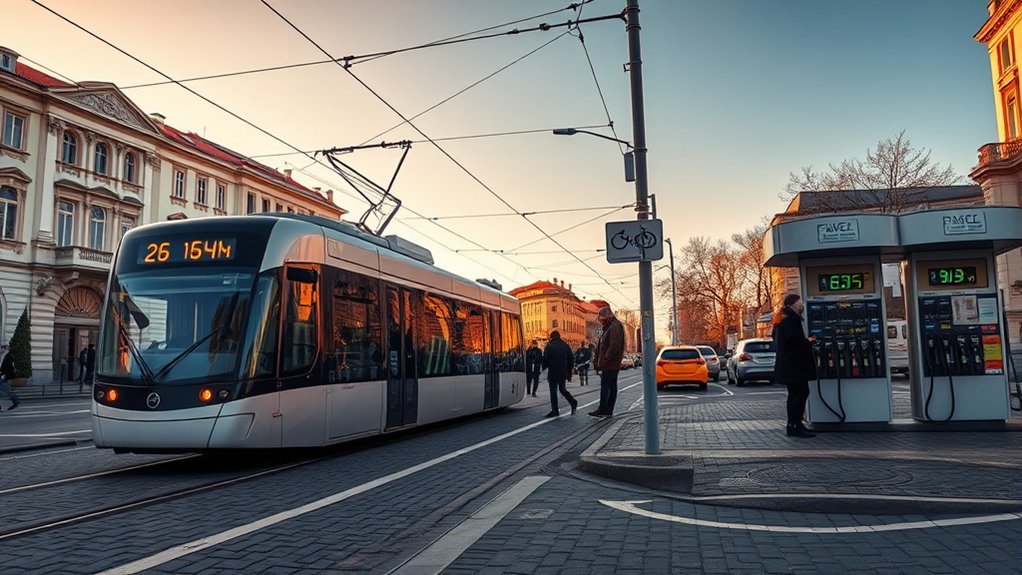
You’ll find public transport in Slovakia is cheap — single tickets run about €1.00–€1.40 and monthly passes near €20 (€32.5 in USD equivalence), so commuting by transit usually beats car costs.
Taxis in Bratislava average around €0.80 per km, which can add up compared with a monthly pass for regular trips.
Fuel prices (petrol ~€1.60/L, diesel ~€1.80/L) make personal car use noticeably more expensive for frequent travel.
Public Transport Fares
One ticket typically costs €1.00–€1.40 in Slovak cities, while a monthly pass at about €20 gives you unlimited local travel, making monthly commuting far cheaper than single fares if you ride regularly.
Taxis in Bratislava run roughly €0.80/km, petrol is around €1.60/l and diesel €1.80/l, and intercity coaches (e.g., Bratislava–Košice, 445 km) start at about €21, offering a low-cost alternative to driving for longer trips.
If you commute daily, a €20 monthly pass amortizes quickly: ten round trips using single tickets would exceed that.
Compare fuel and taxi costs: driving becomes costlier as distance increases and when you factor parking, tolls, and maintenance.
For regional travel, coaches beat both car and occasional flights on price, though they take longer.
Public transit is the most budget-efficient option for regular travel.
Taxi Pricing Structure
How much will a taxi set you back compared with public transit or driving? You’ll pay roughly €0.80 per km in Bratislava: an 8 km trip runs about €14.20, markedly higher than a single public-transport fare (€1.00–€1.40 or about $1.24).
If you commute daily, a monthly travel pass starting at €20 makes public transit far cheaper.
Comparing taxi vs driving, taxis avoid parking and maintenance but can exceed fuel costs quickly—note fuel averages (€1.60/l petrol, €1.80/l diesel) so short solo trips may still favor taxis for convenience, while regular trips favor driving if you already own a car.
In sum: taxis are convenient and pricey per km; public transit and monthly passes offer the best value for routine travel.
Fuel and Petrol Costs
Fuel prices in Slovakia sit at about €1.60 per liter for petrol and €1.80 for diesel, so if you drive frequently those costs add up quickly compared with public transit where single tickets cost €1.00–€1.40 and monthly passes start at roughly €20.
Taxis charge about €0.80/km in Bratislava, making short solo trips sometimes cheaper than driving when you factor parking and maintenance, but regular commuting almost always favors public transport or owning a fuel-efficient car.
You’ll pay roughly €72 to fill a 45‑liter tank of petrol and more for diesel, so estimate monthly fuel based on mileage.
For intercity trips compare coach (€21 Bratislava–Košice) and train (€19.20) fares to avoid unnecessary fuel expenses.
Healthcare, Insurance and Personal Care Expenses

Because healthcare visits and everyday personal-care items stay relatively inexpensive in Slovakia, you’ll find overall out-of-pocket costs lower than in many Western European countries. A short private-doctor visit runs about €50 for 15 minutes, while a box of antibiotics (12 doses) is only ~€3.00, so combined visit-plus-medication stays modest compared with Western peers. Public transport monthly passes (~€42) keep travel to clinics affordable. Personal-care staples are cheap: roll-on deodorant (50 ml) ≈ €3.75 and 32 tampons ≈ €5.50. These figures mean routine care and supplies rarely produce large unexpected expenses.
| Item | Typical Price |
|---|---|
| Private 15-min doctor visit | €50 |
| Antibiotics (12 doses) | €3.00 |
| Deodorant (50 ml) | €3.75 |
| Tampons (32) | €5.50 |
| Monthly transport pass | €42 |
If you compare regionally, Slovakia’s combination of low medication and personal-care prices plus inexpensive transport yields lower recurring health-related outlays than many Western European capitals.
Education and Child-Related Costs

While public schooling in Slovakia is free and compulsory for ages 6–16, families who choose private education typically pay €1,000–€5,000 a year.
University costs vary from about €1,000–€2,000 for Slovak citizens to roughly €3,000–€10,000 for many international students.
You’ll find public schools cover basic tuition; private options offer smaller classes or international curricula for considerably higher fees.
Kindergartens show a clear public–private split: public facilities charge nominal fees, while private kindergartens run €200–€400 monthly.
University costs are moderate for locals but can triple or quintuple for internationals, affecting budget planning.
- Tuition (private school): €1,000–€5,000/year
- University (Slovak): €1,000–€2,000/year
- University (international): €3,000–€10,000/year
- Private kindergarten: €200–€400/month
Extracurriculars cost €20–€100/month; include them when comparing total child-related expenses across public versus private choices.
Entertainment, Sports and Leisure Activities

If you’re budgeting leisure in Slovakia, entertainment and sports are generally affordable compared with Western Europe: student-friendly prices (ISIC discounts) put movie tickets at about €6, museum entries near €2, fitness center access from €5, and swimming pools around €4, while theatre runs €10–€45 and opera/ballet €15–€40.
This means you can pick low-cost regular activities or occasional higher-end performances depending on your priorities. You’ll find low per-visit costs make frequent cultural and sports participation realistic: regular cinema or pool visits cost a fraction of Western European averages.
Theatre and classical performing arts sit higher on the spectrum but still under many major EU cities, so attending monthly is feasible if you budget. ISIC discounts shift cost-effectiveness toward students and young residents; compare membership fees for gyms against pay-as-you-go swim and cinema use.
Monthly Budget Examples for Different Lifestyles

Having outlined typical leisure costs, let’s look at how they fit into full monthly budgets for different lifestyles in Slovakia.
You’ll see clear splits between frugal, comfortable, and city-centric spending based on rent, utilities, food and transport. Use these examples to gauge what fits your situation.
- Frugal single: $1,200 — rent outside center $533, utilities $154, internet $19.1, food and occasional cheap meals ($7–$9.81), monthly transport $32.5.
- Urban one-bedroom: $1,350 — city-center rent $681, same utilities and internet, slightly higher food budget for eating out intermittently.
- Comfortable single: $1,500 — city rent, utilities, internet, regular dining out, modest leisure allocation.
- Commuter saver: ~$1,250 — choose outside-center rent, rely on monthly public transport ticket $32.5, keep food costs low with inexpensive restaurant options.
These estimates use average prices to give comparative, actionable monthly totals without considering taxes or income specifics.
Salaries, Taxes and How Much You Need to Maintain Your Standard of Living
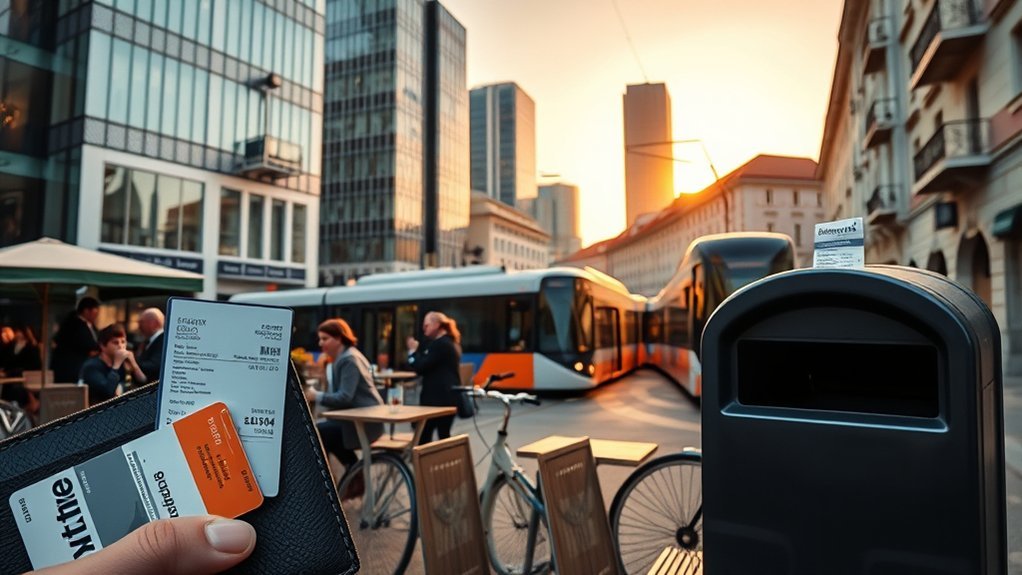
Curious how far your pay will stretch in Slovakia? The average monthly salary is about $950, which covers roughly 1.1 months of living expenses—so before taxes you’re near break-even on average costs.
After taxes, average pay rises to about $1,447 monthly, which exceeds the typical cost of living estimate of $1,300 and lets you live comfortably.
Rent is a major variable: a city-center one-bedroom averages $681, while cheaper options run near $533. Add utilities around $154 for a single person; combined with food and transport, these drive the $1,300 baseline you should budget to match an average Slovak standard.
In short, if you net less than ~$1,300 you’ll likely need to cut housing or discretionary spending; if you net around $1,447 or more, you’ve got breathing room.
Use rent and utility figures to model scenarios based on your priorities and location.
Moving to Slovakia: Visas, Relocation Costs and Practical Advice
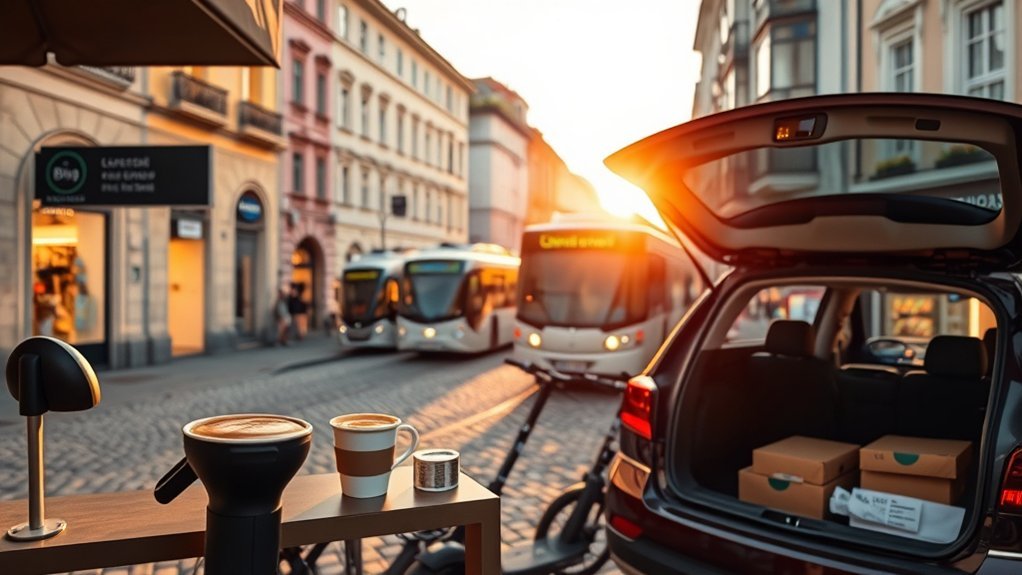
Now that you know typical salaries and living costs, let’s look at what it actually takes to move to Slovakia: visas vary by nationality and purpose (work, study, family reunification), and each has specific paperwork and processing times you should factor into your budget and timeline.
You’ll compare costs to average incomes: the mean monthly salary is about $950, so plan accordingly.
- Visa & paperwork: check category requirements early; processing times affect start dates and potential lost income.
- Relocation shipping: expect €1,000–€3,000 depending on volume and distance; cross-border moves cost more.
- Initial savings: aim for €3,000–€4,000 to cover first months’ rent, utilities, deposits, and groceries.
- Rent comparison: city-center one-bed ≈ $681; outside center ≈ $533 — factor commute and lifestyle trade-offs.
Use this data to build a realistic timeline and cash buffer; shortfalls often come from underestimated shipping or delayed visa approvals.
Frequently Asked Questions
How Much Do You Need to Live in Slovakia?
You’ll need about $1,300 monthly to live comfortably in Slovakia. That’s slightly below the average $1,447 net salary, so you’ll cover ~1.1 months’ expenses; rent, utilities, and transport determine whether you’ll save or stretch.
Is Slovakia Cheap or Expensive?
Slovakia’s generally cheap compared to Western Europe; you’ll spend about $1,300 monthly on average, with Bratislava pricier (one-bedroom ~$681), local transport ~$32.5, and average after-tax wages around $1,447, so it’s affordable.
Is Slovakia a Good Place to Live In?
Yes — you’ll enjoy decent public transit, affordable dining, and varied housing, though salaries lag. Compared to Western Europe you’ll stretch money further in smaller towns; Bratislava costs more, so pick location wisely for balance.
What Is the Average House Price in Slovakia?
The average house price in Slovakia varies, but you can expect city-center one-bedroom rents around $681 and three-bedroom about $1,185, while outskirts drop to $533 and $893 respectively, reflecting size and urban premium differences.
Conclusion
Overall, Slovakia’s cost of living is attractively low compared with Western Europe: you’ll pay about 45–55% of what you’d spend in Germany or France. Rent and groceries are the biggest savings — for example, a one-bedroom in Bratislava averages €600–€800, roughly half of similar cities in neighboring Austria. With average net monthly salaries around €950, you’ll want to budget carefully if you’re living in the capital, but elsewhere your money will stretch considerably further.

